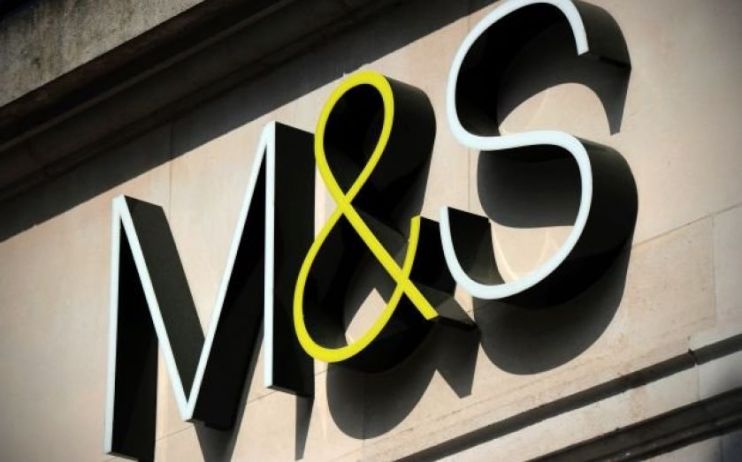Marks & Spencer profit knocked lower by poor clothing sales

Weak clothing and home sales knocked profit 17 per cent lower at Marks & Spencer in its latest half-year, it revealed today.
But the high street chain’s share price led the FTSE risers, climbing up 5.3 per cent to 192.05p, as investors felt it could have been a lot worse as boss Steve Rowe said his company was now “making up for lost time”.
Read more: Marks & Spencer’s exit from the FTSE is a sign of its terminal decline
The figures
Revenue fell 2.1 per cent year on year to £4.86bn in the six months to the end of September.
Meanwhile profit before tax declined 17.1 per cent to £176.5m owing to poor first half clothing and homeware sales.
Basic earnings per share rocketed 74.3 per cent to year on year to 6.1p and the retailer also cut net debt 3.7 per cent to leave it at £4.13bn.
However, M&S’s interim dividend plunged 40 per cent to 3.9p, down from last year’s 6.5p.
Why it’s interesting
Like-for-like sales plunged 5.5 per cent in the high street stalwart’s clothing and home divisions, despite a better performance in October.
Meanwhile total revenue for the two units dropped 7.8 per cent, with the retailer warning that “in a declining market, the business underperformed”.
Markets.com’s chief market analyst, Neil Wilson, said the divisions’ performance appeared “grim” after Rowe binned top staff to take control of the division himself to speed up progress.
Meanwhile M&S’s online business climbed just 0.2 per cent, compared to Next’s nine per cent increase.
Read more: Next sales beat third quarter guidance, but store decline worries investors
Today Rowe said the retailer was “making up for lost time”, as it pivots to digital and fights budget supermarkets with price cuts.
It has paid £750m to launch an online food delivery service with Ocado, but that will not kick in until 2020.
The retailer was booted from the FTSE 100 in September, as one of only 28 original constituents of London’s blue-chip index.
Arlene Ewing, investment manager at Brewin Dolphin, said M&S’s one bright spot remains food, with its like-for-like growth of 0.9 per cent.
“The deal with Ocado also appears to be on track, which could make a significant difference to Marks & Spencer’s food offering when it is fully in place,” she added.
“However, there is still a lot of work to be done to transform one of the UK’s most iconic brands – especially at its struggling divisions.”
But M&S’s 2020 forecast remained cautious, predicting a loss of two per cent in clothing and home sales due to net store closures.
Meanwhile the retailer’s profit margin is expected to fall by anywhere between 0.25 and 0.75 per cent.
It is targeting cost savings of at least £350m by 2020-21.
Investors had hoped for signs of a turnaround after M&S posted a 10 per cent drop in profit in its last full year.
But Emma-Lou Montgomery, associate director of Fidelity Personal Investing’s share dealing service, called the results a “mixed bag”.
“M&S is clearly pulling out all the stops in a bid to turn its business around. It’s going head-to-head with the lower-cost supermarkets with hundreds of price reductions across its food range,” she added.
Read more: Marks & Spencer ejected from FTSE 100 for the first time in 35 years
“Then on the clothing side of the business it’s trying to win-back old loyalty with the relaunch of its failing Per Una range, as well as apparently hoping to compete, to some extent, with the fast-fashion industry, by speeding up its ranges and bringing down its prices.
“At the same time it’s hoping to position itself as a digital first business, with the roll-out of free next day delivery and a new loyalty scheme on the way.”
“It’s an exhausting mix; clearly taking the most successful elements of retail from everywhere else and trying to apply them to the M&S model. Will it work? Time will tell.”
What Marks & Spencer said
Chief executive Steve Rowe said:
Our transformation plan is now running at a pace and scale not seen before at Marks & Spencer. For the first time we are beginning to see the potential from the far reaching changes we are making. The Food business is outperforming the market. Our deal to create a joint venture with Ocado is complete and plans to transition to the M&S range are on track.
In Clothing & Home we are making up for lost time. We are still in the early stages, but we are clear on the issues we need to fix and, after a challenging first half, we are seeing a positive response to this season’s contemporary styling and better value product. We have taken decisive action to trade the ranges with improved availability and shorter clearance periods. In some instances dramatic sales uplifts in categories where we have restored value, style and availability illustrate the latent potential and enduring broad appeal of our brand. Our cost reduction and store technology programmes are on track.
M&S chief executive Steve Rowe